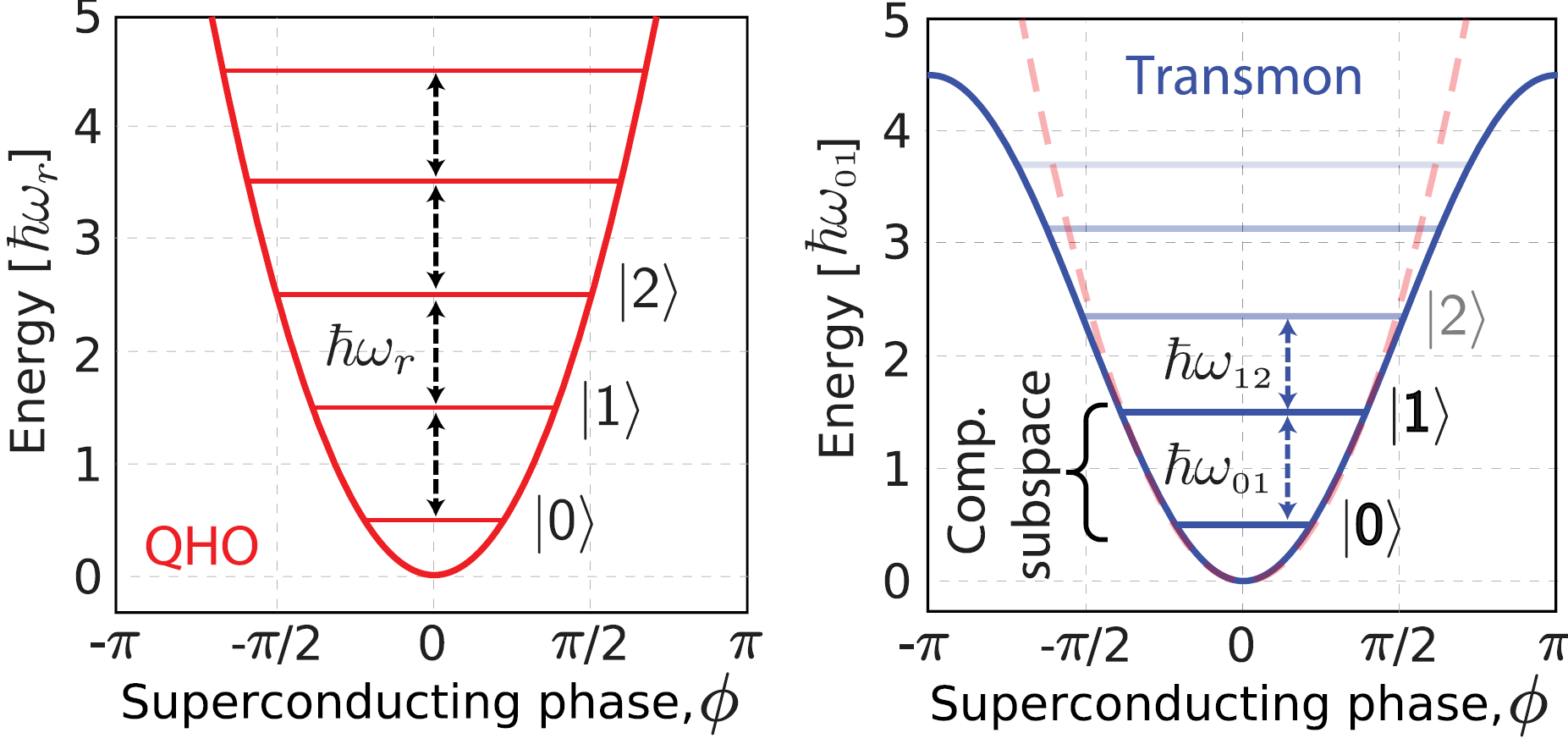Fundamental transmon physics
Since transmon qubit is a non-linear LC circuit, we expect some deviation of the Hamiltonian from the linear LC oscillator, as seen in Fig. 1. [1]

Given that the superconducting phase is \(\phi\). Since Josephson Junction has the current \(I = I_c \sin \phi\) while the potential difference is \(V = \frac{\Phi_0}{2\pi} \frac{d\phi}{dt}\) (here, \(\Phi_0 = \frac{h}{2e}\) is the magnetic flux quantum), it can be shown that Josephson Junction can be modeled as a non-linear inductor, where
\begin{equation} L_{\text{eff}} = \frac{\Phi_0}{2\pi I_c} \frac{1}{\cos \phi} \end{equation}
Hence, the effective transmon energy can be expressed as
\begin{equation} \hat{H} = 4 E_C (\hat{n} - n_g)^2 - E_J \cos \hat{\phi} \end{equation}
where \(E_J = \frac{\Phi_0 I_c}{2\pi}\) giving the energy landscape as shown in Fig. 1. [1]
Rearranging the Hamiltonian in Eq. (2) using the ladder operator \(\hat{b}\), we obtain
\begin{equation} \hat{H} = \hbar \omega_q \left( \hat{b}^\dagger \hat{b} + \frac{1}{2} \right) + \frac{\alpha}{2} \hat{b}^\dagger \hat{b}^\dagger \hat{b} \hat{b} \end{equation}
The second term is not found in linear LC resonator, hence giving \(\alpha = -E_C = -\frac{e^2}{2C_q}\) the term non-linearity or anharmonicity.
Obtaining the eigenenergies yields:
\begin{equation} E_m \approx -E_J + \sqrt{8 E_C E_J} \left(m + \frac{1}{2} \right) - \frac{E_C}{12} (6m^2 + 6m + 3) \end{equation}
Simple calculations from Eq. (4) will provide:
\[\begin{align*} \omega_{01} &= E_1 - E_0 &= \sqrt{8 E_C E_J} - E_C &= \omega_p + \alpha \\ \omega_{12} &= E_2 - E_1 &= \sqrt{8 E_C E_J} - 2E_C &= \omega_{01} + \alpha \\ \omega_{23} &= E_3 - E_2 &= \sqrt{8 E_C E_J} - 3E_C &= \omega_{01} + 2\alpha \\ \omega_{n, n+1} &= E_{n+1} - E_n &= \sqrt{8 E_C E_J} - n E_C &= \omega_{01} + n\alpha \end{align*}\]One may also show that \(E_{0m} = m \omega_{01} + \frac{\alpha}{2} m(m-1)\)
The number of states in the transmon is limited by the energy barrier \(2 E_J\). Hence, we can approximate that
\begin{equation} N \approx \frac{2 E_J}{\hbar \omega_{01}} \end{equation}
For \(E_J = 13.6GHz\) and \(\omega_{01} = 5GHz\), we obtain \(N \approx 5\) levels [3].
References
[1] J Koch et al, Charge-insensitive qubit design derived from the Cooper pair box, Physical Review Applied 2007.
[2] P Krantz et al, A quantum engineer’s guide to superconducting qubits, Applied Physics Reviews 6, 021318 (2019)
[3] Z Wang et al, High-EJ/EC transmon qudits with up to 12 levels, Physical Review Applied 2025.
Enjoy Reading This Article?
Here are some more articles you might like to read next: